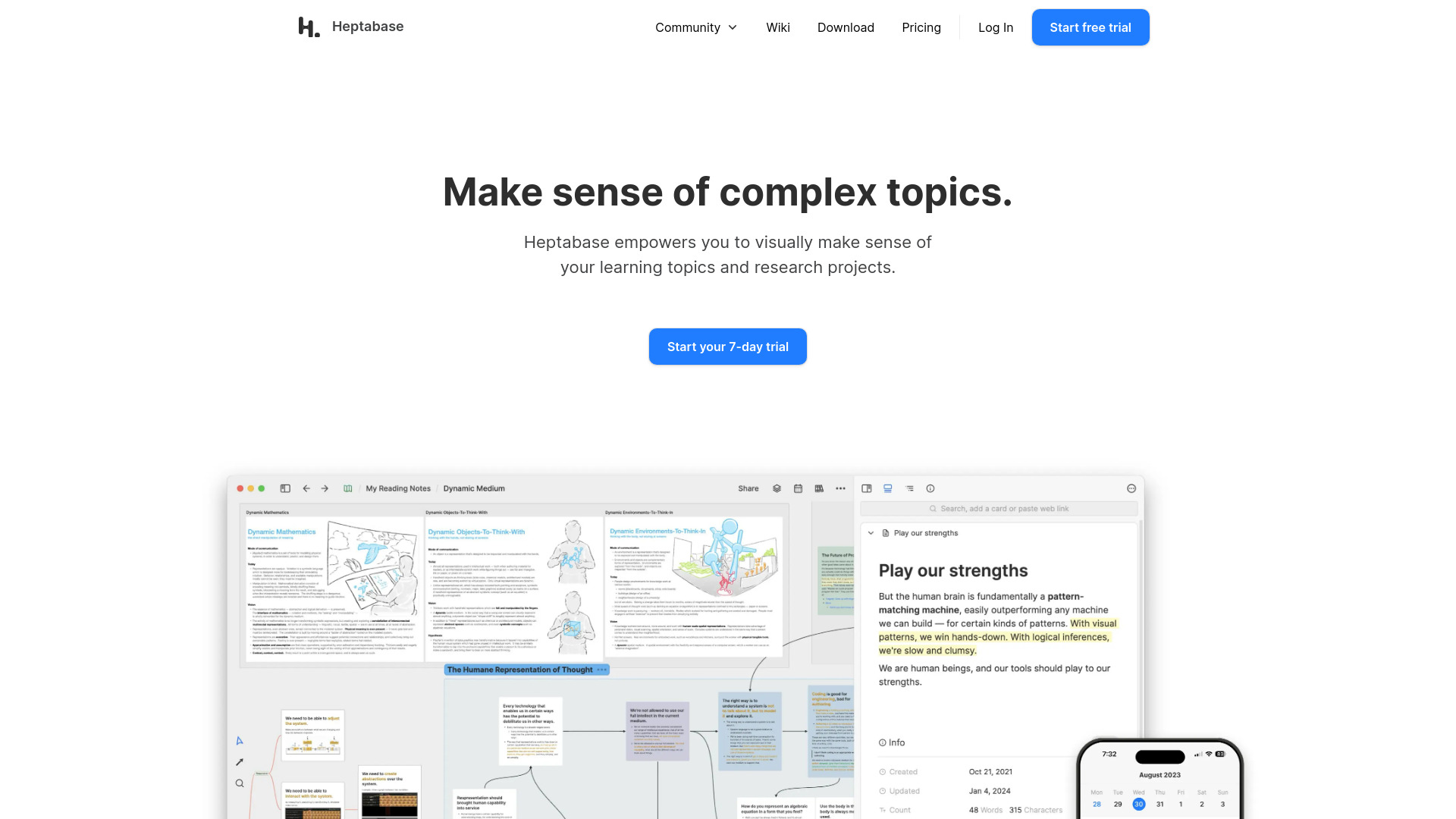- Home
- AI Knowledge Management
- Heptabase

Heptabase
Open Website-
Tool Introduction:Visual note-taking with AI: boards, mind maps, PDFs, real-time sync.
-
Inclusion Date:Oct 28, 2025
-
Social Media & Email:
Tool Information
What is Heptabase AI
Heptabase AI is the intelligent layer of Heptabase, a visual note-taking and knowledge management workspace. It helps you make sense of complex topics and research projects by combining whiteboards, mind maps, tables, and Kanban on a single canvas. Capture and annotate PDFs, audio, video, and journals, then use AI to summarize long materials, extract key ideas, ask questions across your notes, and reveal connections. With real-time sync, collaboration, and offline access, Heptabase AI keeps research organized and actionable anywhere.
Heptabase AI Main Features
- Visual whiteboards and mind maps: Organize concepts spatially, cluster ideas, and map relationships to accelerate understanding.
- Card-based notes and linking: Break topics into cards, add tags and references, and connect them to build a coherent knowledge structure.
- Multimedia and PDF annotation: Import PDFs, audio, and video; highlight, comment, and pull key excerpts into your workspace.
- AI summarization and Q&A: Generate concise summaries, extract action items, and ask questions that reference content across notes and documents.
- Outlines and synthesis: Turn scattered research into outlines, briefs, or study guides with AI-assisted drafting.
- Search and organization: Find information quickly with filters and tags; keep projects structured with tables and Kanban boards.
- Collaboration: Share boards with teammates, co-edit, leave comments, and stay aligned with real-time sync.
- Offline-first experience: Work offline and sync changes automatically when back online.
Who Should Use Heptabase AI
Heptabase AI suits researchers, students, product managers, UX designers, analysts, consultants, and knowledge workers who need to synthesize large, complex information. it's ideal for literature reviews, user research, strategy planning, and any scenario where visual structure, PDF annotation, and AI-assisted reasoning improve speed and clarity.
How to Use Heptabase AI
- Create a workspace and open a whiteboard for your topic or project.
- Import sources such as PDFs, audio, video, and journal entries; add notes and highlights.
- Break information into cards and arrange them into mind maps, clusters, tables, or Kanban lanes.
- Use AI to summarize long documents, extract key points, and draft outlines or to-do lists.
- Ask AI questions that reference multiple notes to surface relationships and gaps.
- Tag and link cards to refine structure; iterate on the whiteboard as your understanding grows.
- Share with collaborators, co-edit in real time, and review updates across devices.
- Work offline when needed; changes sync automatically when you reconnect.
Heptabase AI Industry Use Cases
- Academia: Conduct literature reviews by annotating PDFs, mapping theories, and using AI to synthesize findings.
- UX Research: Consolidate interview notes, tag insights, cluster themes on a whiteboard, and generate research summaries.
- Product Management: Plan discovery, organize feature ideas in Kanban, and have AI draft briefs or PRDs from research notes.
- Marketing & Content: Build topic maps, summarize source materials, and outline articles with AI assistance.
- Consulting: Create client knowledge hubs, link analyses, and produce executive summaries faster.
Heptabase AI Pricing
Heptabase AI is available within Heptabase’s paid offerings. Specific plan details, AI usage limits, and any free trials may change over time; check the official pricing information for the most current options.
Heptabase AI Pros and Cons
Pros:
- Visual-first workspace with whiteboards and mind maps that clarifies complex topics.
- Strong PDF annotation and multimedia support in one place.
- AI-assisted summarization, outlining, and cross-note Q&A speed up synthesis.
- Real-time collaboration with offline access for flexible workflows.
- Tables and Kanban boards help track research and project tasks.
Cons:
- Canvas-based workflows can have a learning curve for new users.
- AI outputs require review; quality depends on source material and prompts.
- Large boards with heavy media may feel resource-intensive on low-end devices.
- Teams needing advanced enterprise governance may require additional tooling.
Heptabase AI FAQs
-
Does Heptabase AI work offline?
Core note-taking and whiteboards work offline, syncing when you reconnect. AI features typically require an internet connection.
-
Can I annotate PDFs and use AI to summarize them?
Yes. Import PDFs, highlight key sections, and ask AI to summarize or extract key points for faster review.
-
Is collaboration supported?
Yes. You can share spaces, co-edit in real time, leave comments, and keep everyone aligned across devices.
-
What kinds of projects benefit most?
Research-heavy work—such as literature reviews, user research synthesis, product discovery, and strategy planning—benefits from the visual structure and AI assistance.
-
How is my data used by AI?
AI processes the content you provide to generate answers and summaries. Review the service’s privacy and data policies for specifics on retention and security.



